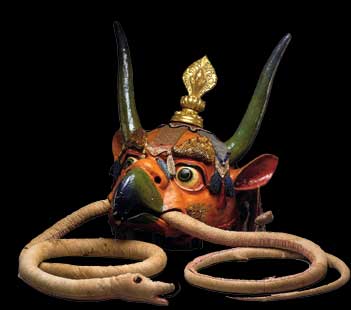|

 |
Horned
Garuda
Polychromed papier-mâché mask, silk, and cotton;
late 19th-early 20th century
Chojin Lama Temple Museum, Ulaan Baatar
The ancient Indian sun-eagle, always represented in the act
of devouring a snake, appears in Lamaist art at the top of the
nimbus of images. He was adopted from the shamanist tradition
into the Buddhist pantheon of Mongolia and the repertoire of
the Tsam festival as one of the Four Terrifying Faces, who were
regarded as incarnations of famous shamans of antiquity. Garuda
was identified with the spirit of Mt. Bogdo Ula, which rises
to a thousand meters above the grasslands south of the present-day
Ulaan Baatar. The addition of the horns suggests that Garuda
may also have been associated with the horned heavenly bird
Khyung, which plays a role in the legends of all countries of
the Himalayas. |
July 12 - September 17, 2000
Asia
Society at Midtown
502 Park Avenue, at 59th Street
The Asia Society exhibition is drawn from the larger exhibition
Dancing Demons of Mongolia presented at the Nieuwe Kerk Museum
in Amsterdam. The material on this Web site has been adapted from
the book Dancing Demons of Mongolia by Jan Fontein and other
sources.
Dancing Demons: Ceremonial Masks of Mongolia and related
Mongolia programs are made possible by the Trust for Mutual Understanding,
Frank and Lisina Hoch, John Guth, The Cynthia Hazen Polsky and Leon
B. Polsky Fund, Kathryn and Ernest H. Frank, Eleanor Briggs, Susan
Lynch, and Frederick W. Richmond.
Support for the Asia Societyís Cultural Programs is provided by
the Friends of Asian Arts, Wallace - Readerís Digest Funds, The
Starr Foundation, The Armand G. Erpf Fund, The Arthur Ross Foundation,
the Harold J. and Ruth Newman Philanthropic Fund, and the New York
State Council on the Arts.
Web site by Smith Renaud,
Inc.
|
